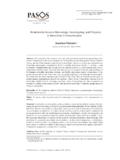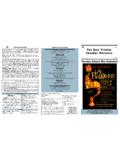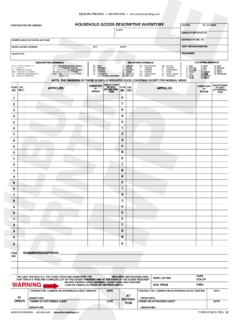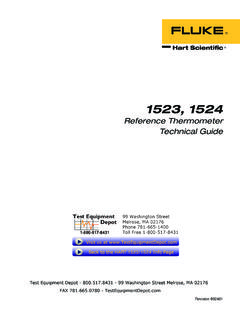Transcription of Impact of Tourist Perceptions, Destination Image …
1 PASOS. Revista de Turismo y Patrimonio Cultural. ISSN 1695-7121 Revista de Turismo y Patrimonio 11 N 3. Special Issue. p gs. 67-78. 2013 Impact of Tourist perceptions , Destination Image and Tourist Satisfaction on Destination Loyalty: A Conceptual Model R Rajesh*Pondicherry University, Puducherry, IndiaAbstract: The objective this research paper is develops a Destination loyalty theoretical model by using Tourist perception, Destination Image and Tourist satisfaction. These study analysis components, attributes, factor influencing the Destination Image and examine the Tourist satisfaction and determinants of Destination loyalty. This is a conceptual paper attempts at evaluating recent empirical on Destination Image , Tourist satisfaction and loyalty. The conceptual framework model is developed on the basis of existing theoretical and empirical research in the field of Destination marketing.
2 The models include four constructs. Tourist Perception constructs has been influenced by factors like Historical and Cultural Attractions, Destination Affordability, Travel Environment, Natural Attractions, Entertainments and Infrastructure. Destination Image construct has been influenced by factors like Infrastructure & Facilities, Heritage Attractions, Natural Made Attractions, Destination Safety & Cleanness, Friendly Local Community & Clam Atmosphere, Rejuvenation and Service Price and Affordability. The satisfaction construct has been influenced by factors like Entertainments, Destination Attractions and Atmosphere, Accommodation, Food, Transportation Services and Shopping. The Destination loyalty construct has influenced by intentions to revisit, word of mouth promotion and recommending to others. The earlier study result reveals that Tourist perception, Destination Image and Tourist satisfaction directly influence Destination loyalty.
3 The outcomes of the study have significant managerial implications for Destination marketing managers. Key words: Perception, Image , Satisfaction, Loyalty, Attributes and IntroductionThe Impact of Tourist perception, destina-tion Image and satisfaction on loyalty has been trendy research topic in tourism research. It is very important to determine the destina-tion Image while taking decisions for strategic marketing of tourism destinations . Because it is assumed that it will result in a positive Image of a Destination , loyalty to Tourist destinations and satisfaction felt by tourists, such as variables (Suzan Coban, 2012). The loyalty is a concept closely related to tourists satisfaction and as a result even with the ideas there is a high degree of satisfaction with loyal tourists. However, in the context of travel and tourism, a review of literature reveals an abundance of studies on Destination Image , Tourist satisfaction and des-tination loyalty has not been thoroughly inves-tigated (Oppermann, 2000).
4 Therefore, it is time for practitioners and academics to conduct more studies of loyalty in order to have greater kno-wledge of this concept, to understand the role of customer satisfaction in developing loyalty, the Impact of other non-satisfaction determinants on customer loyalty, and their interrelationships * Dept. of Tourism Studies, School of Management, Pondicherry University, Puducherry, India. Email: Revista de Turismo y Patrimonio Cultural, 11 N 3. Special Issue. Julio 2013 ISSN 1695-712168 Impact of Tourist perceptions ..,(Christina Geng Qing Chi & Hailin Qu, 2008). The effects of Destination Image and satisfaction on Destination loyalty are studied in the present Objectives of the study1. The study the Impact of Tourist percep-tions, Destination Image and satisfaction on Tourist loyalty;2. To analysis the components, attributes and factors influence of the Tourist percep-tion and Destination Image ; 3.
5 To examine the attributes of Tourist satis-faction ; and 4. To expose the determinants of Destination loyalty. 3. Conceptual Destination ImageDestination Image has been one of the key areas of tourism research for more than four decades (Svetlana & Juline, 2010). Image is defined as the people feelings of anything that they aware (Boulding, 1956). Image is defined as people hold are a way of organizing the different stimuli received on a daily basis and help make sense of the world in which we live (Mayo, 1973). Destination Image is defined as an expression of knowledge, impressions, pre-judices, imaginations and emotional thoughts an individual has of a specific place (Lawson and Baud Bovy, 1977). Image further defined as the sum of beliefs, impressions, ideas and percep-tions that people hold of objects, behaviors and events (Crompton, 1979). Destination Image defined as the overall perception of the desti-nation that is formed by processing information from various sources over time (Assael, 1984).
6 Ideas or perceptions held individually or collec-tively about a Destination by people (Embacher & Buttle, 1989). Image defined as the sum of beliefs, attitudes, impressions that a person or group has of an object and impressions may be true or false, real or imagined (Barich and Kotler 1991). Image is defined as an internali-sed, conceptualised and personalized understan-ding of what one knows (Ahmed, 1996). Des-tination Image is defined as the perception of groups of people (Jenkins, 1999). perceptions or impressions of a Destination held by tourists with respect to the expected benefit or consump-tion values (Tapachai & Waryszak, 2000). Tota-lity of impressions, beliefs, ideas, expectations, and feelings accumulated towards a place over time by an individual or group of people (Kim & Richardson, 2003). Destination Image is an interactive system of thoughts, opinions, fee-lings, visualisations, and intentions toward a Destination (Tasci et al.)
7 , 2007). Components of Destination ImageDestination Image made up of two compo-nents of Image , the components were organic images and induced images. Organic images formed by individuals themselves through past experiences with destinations and unbiased sources of information ( news, reports, news-paper articles and movies). Induced images cre-ated through information received from external sources, including Destination advertising and promotion (Gunn, 1972). Destination Image encompasses only cognitive Image components. Cognitive Image refers to beliefs, impressions, ideas, perceptions and knowledge that people hold on objects (Crompton, 1979). The overall or totality of Image or impression based on indivi-dual attributes and also reveals the relationship between cognitive attributes and overall Image (Keown et al, 1984). The totality of Image depends on evaluations of different products and services (Mazursky, D & Jacoby, J, 1986).
8 Tourist perceptions of Destination attributes of various activities and attractions within an area will interact to form overall Image (Gartner, 1986). The images were formed by cognitive and affective judgments, affective judgments based on individual feelings and emotions towards an object (Baloglu et al, 1997; Walmsley, 1998 & Baloglu & Mangaloglu 2001). Dann (1996) suggested Destination Image were created by cognitive, affective and conative. Cognitive com-ponent made up of the sum of beliefs, impres-sions, ideas and perceptions that people hold of an object. The affective component deals with how a person feels about the objects. Attributes of Destination ImageCharlotte and Ritchie (1991) the Destination Image researchers were used following attribu-tes to measure the Destination Image , the attri-butes were scenery or natural attractions, costs or price levels, climate, Tourist sites or activities ,nightlife and entertainment, sports facilities or activities, national parks or wilderness activi-ties, local infrastructure, transportation, archi-tecture or buildings, historic sites, museums, beaches, shopping facilities, accommodation facilities, cities fairs, exhibits, festivals, facilities PASOS.
9 Revista de Turismo y Patrimonio Cultural, 11 N 3. Special Issue. Julio 2013 ISSN 1695-7121R. Rajesh 69 for information and tours, crowdedness ,cleanli-ness, personal safety, economic development or affluence, accessibility, degree of urbanisation, extent of commercialization, political stability, hospitality or friendliness or receptiveness, different customs or culture, different cuisine or food and drink, restful or relaxing, atmosphere, opportunity for adventure, opportunity to incre-ase knowledge, family or adult oriented ,qua-lity of service and fame or reputation. Sonmez S. & Sriakaya E. (2002) used this attributes to measure Destination Image , architectural styles, local festivals, archeological treasures, natural scenic beauty, cities, museums & art galleries, adventure, weather, cultural heritage, plenty of places to get away from crowds, local people are friendly, good-quality restaurants, hotels are easy to find , restful and relaxing place to visit, food, lifestyles and customs, standard of living, dress, road conditions, cleanliness and hygiene, safe and security, culture, shopping facilities, nature preserves and wilderness areas, Tourist information, tour availability, skiing opportu-nity, national parks, price and good value for and Martin (2004) categorized attribu-tes into nine dimensions.
10 (1) natural resources ( weather, temperature, rainfall, hours of sunshine, beaches, quality of seawater, length of beaches, overcrowding of beaches, wealth of countryside, protected natural reserves, lakes, mountains, deserts, variety and uniqueness of flora and fauna); (2) Tourist leisure and recrea-tion ( accommodation, number of beds ,cate-gories, quality, restaurants number, quality, bars, discos and clubs, hotels and self-catering, ease of access, excursions at Destination , Tourist centers and network of Tourist information); (3) natural environment ( beauty of the scenery, attractiveness, cleanliness, overcrowding, air and noise pollution and traffic congestion); (4) general infrastructure ( development and quality of roads, airports and ports, private and public transport facilities, development of health services, development of telecommunica-tions, development of commercial infrastructure, extent of building development); (5) culture, history, and art ( festival, concerts, handi-craft, gastronomy, folklore, religion, museums, historical buildings, monuments, customs and ways of life); (6) social environment ( quality of life, underprivileged and poverty, language barriers, hospitality and friendliness of the local residents); (7) Tourist infrastructure ( accommodation, number of beds ,categories, quality, restaurants number, quality, bars, dis-cos and clubs, hotels and self-catering, ease of access, excursions at Destination , Tourist centers, network of Tourist information).










